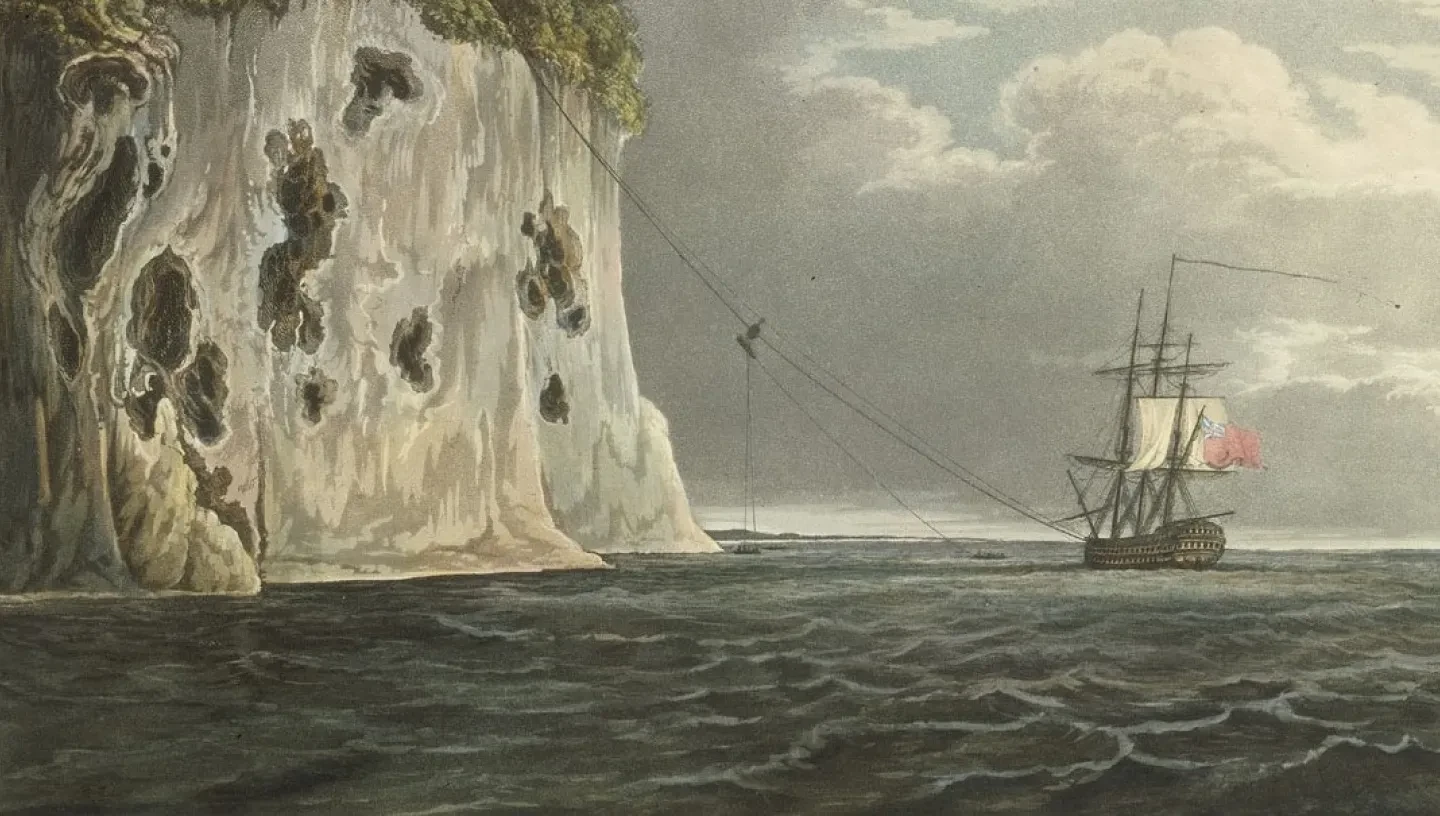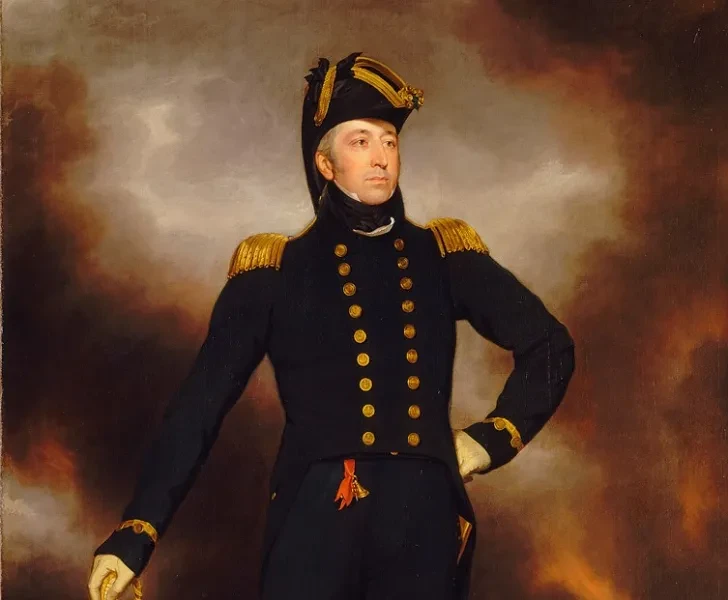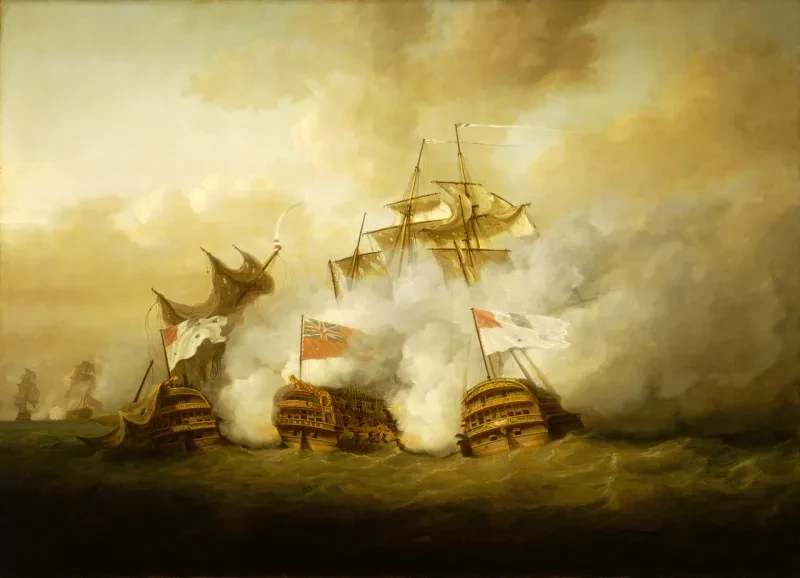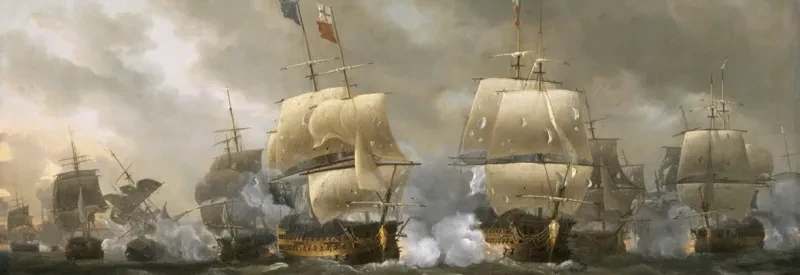
This Caird Library & Archive blog looks at the occupation and brief naval career of Diamond Rock, one of the Royal Navy’s first stone frigates
A strategic gem
In 1804, with Britain at war with France, the bulk of the Royal Navy was employed in blockading French ports to prevent Napoleon’s planned invasion of Britain. In the Caribbean, a small force led by Commodore Sir Samuel Hood was left to protect British interests in the region.
With over a thousand miles of islands and ocean to patrol, he had only two ships-of-the-line, including his flagship the Centaur, six frigates and a few smaller vessels available to him. Looking to make the most of his limited resources, Hood had the idea of occupying a small uninhabited island about two miles off the coast of French-held Martinique, and some of the story of how they went about this can be told through the images and journals available within our collections.
The island was known as Diamond Rock due to the way its salt-encrusted surface sparkled in the sunlight when viewed from certain angles. It was a forbidding rock rising almost 200 metres above the waves and populated only by seabirds, venomous snakes and other lizards.
Its strategic position amid local shipping routes would allow those who held it to effectively blockade the nearby ports and spot ships approaching for miles around. To lead the initial landing party, Hood chose the Centaur’s first lieutenant, James Wilkes Maurice.
The rock was known to contain some caves, but when Lieutenant Maurice and his party managed to land and explore, they found these to be both larger than expected but also relatively dry and therefore suitable for storing supplies or acting as sleeping quarters.
After a perilous climb, Maurice managed to find a route to the summit and a series of rope ladders were constructed, secured by metal spikes driven into the rockface. Additional men were landed including sappers who set about blasting the rock to expand the caves while carpenters constructed a landing stage.
With the caves cleared they established a galley, forge, and water cistern, filled sleeping areas with hammocks, and pitched tents for the officers.
Hood and Maurice planned several gun batteries for the rock. The first of these involved landing three 24-pounder guns from the Centaur which were ferried across in a 40-foot launch.
Two were mounted just above sea level, covering different approaches to the rock, while a third named Hood’s Battery in Sir Samuel’s honour was positioned in a cave some 60 metres up the cliffside. Finally, Hood intended to mount two 18-pounder long guns at the summit.
German-born painter John Eckstein who was on board the Centaur at this time, produced a series of drawings, later published, recording the work of the crew - some copies of which are held in the Museum’s collection.
With the Centaur anchored as close as possible to the rock and lines run down to its mainmast from the cliff tops, Eckstein was rowed off to a better vantage point to sketch the difficult operation. With Maurice on the rock and the Centaur’s Captain Maxwell on deck shouting orders through speaking trumpets, the crew would spend the better part of a day working at the capstan to propel the first gun to the cliff top.
The following day the second gun was successfully hauled up in around half the time and both were secured on their mountings at the summit.
On 1 March 1804, with the guns now in place and the rock supplied with four months’ provisions for 120 men, Hood completed a final inspection and bid farewell to Maurice whom he had appointed Commander of His Majesty’s sloop-of-war Diamond Rock.
A six-gun sloop, Fort Diamond was also attached to the rock and would be used to halt and inspect ships. With visibility for up to 40 miles from the summit on a clear day, the garrison was also to keep watch for the arrival of any enemy warships and to pass information on to St Lucia and any British ships in the area.
Life on board Diamond Rock
Eckstein remained on the rock to record the life and work of the garrison. In a letter to a friend later published in The Naval Chronicle, he praised the ingenuity of the British seamen, lamented that his pencil was unable to keep pace with their labours and wrote of how he loved his time on the rock with the relative isolation, the roar of the sea and the star-filled sky.
The images he produced show a small part of life on the rock with men relaxing near their hammocks or hard at work hauling the ‘mail-coach’, a large cask suspended from the hauling tackle they had constructed. While originally intended for moving powder and shot to the upper batteries, Maurice soon found it useful as a lift allowing his regular inspections and general crew rotations to be completed quickly.
He commanded the rock as he would have a ship, complete with a ship’s bell and the usual division of the day into watches. The men appear to have enjoyed life on the rock, particularly the food, as canoes from Martinique risked the trip out to the rock to trade fresh fish and fruit, which made a welcome change from their salted provisions.
They were also kept busy intercepting ships, conducting gunnery and musket drills, while relaxation included games of cricket played within the confines of the caves. The caves also contained space for a small hospital, and British ships passing the rock would soon begin dropping off those in need of care.
The surrender of a 'symbol of British insolence'
The British occupation of Diamond Rock eventually attracted the attention of Napoleon himself. His wife, Empress Josephine, had been born and raised in Martinique, where her family and friends still resided. Perhaps because of this connection, Napoleon became increasingly frustrated with this ‘symbol of British insolence on the doorstep of Martinique’ and insisted it be removed at the first opportunity.
When a combined French-Spanish fleet under Vice-Admiral Villeneuve managed to elude Nelson’s fleet in the Mediterranean and escape across the Atlantic, reaching Martinique in May 1805, Villeneuve’s various orders included instructions that he was to remove the British from the rock at all costs.
Unfortunately for Maurice and his men, the arrival of this large enemy fleet coincided with the discovery of a crack in their main water tank, thought to have been caused by a small earthquake and then worsened by the firing of the guns as the enemy sailed past.
Their remaining water was now rationed to one pint a day per man, but would soon run out, and an attempt to obtain supplies from St Lucia was intercepted by the French. On 31 May, Villeneuve moved sixteen of his ships to attack, along with eleven longboats carrying troops and began a bombardment of the rock, which would last for over two hours.
Diamond Rock’s gunners managed to sink two of the longboats, but the overwhelming firepower of the enemy quickly forced Maurice to have his men abandon the lower batteries, destroy the landing stage and retreat to the caves. Hundreds of French troops landed under musket fire from the seamen and marines and had to struggle past debris caused by the bombardment.
Two 74-gun ships maintained regular fire towards the summit, limiting opportunities for the upper batteries to provide support.
The defence would last almost three days, and by 2 June the men were so weak from dehydration they could barely lift their muskets, whilst nearly exhausting their supply of ammunition. After consulting with his officers, Maurice threw out a flag of truce to discuss their surrender and terms were quickly agreed, after which the French brought their prisoners much-needed water. Two men had been killed and another seriously injured on the British side, while accounts of French casualties differ, ranging from fifty to several hundred.
Villeneuve’s fleet would soon return to France as he sought to continue avoiding Nelson’s pursuit, but both he and most of the ships involved in the capture of Diamond Rock would fight at Trafalgar later that year. Having surrendered his command, Maurice faced a court martial once he returned to a British held port, but the efforts made to defend the rock in the face of a superior enemy force meant he was honourably acquitted.
He continued his naval career which would later include command of another island, Anholt in the Kattegat, acting as governor between 1810-1812. After this he didn’t serve at sea again, but would eventually reach the rank of rear-admiral while on the retired list.








